thiruki@cogeco.ca |
Board |
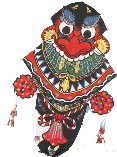 |
Fukue Island
|

|
 FUKUE-SHIMA (Fortune Inlet Island) is the largest land mass in the
Goto-retto (Five Island Archipelago),
a group of about 100 islands (5 of them big) in the East China Sea, off the west coast of Kyushu near Nagasaki in southern Japan.
Fishing and farming are the traditional activities here, however the tourism
industry has been growing of late, as people come to discover the island's sandy beaches,
scuba diving, hot springs, golf courses and delicious fish!
FUKUE-SHIMA (Fortune Inlet Island) is the largest land mass in the
Goto-retto (Five Island Archipelago),
a group of about 100 islands (5 of them big) in the East China Sea, off the west coast of Kyushu near Nagasaki in southern Japan.
Fishing and farming are the traditional activities here, however the tourism
industry has been growing of late, as people come to discover the island's sandy beaches,
scuba diving, hot springs, golf courses and delicious fish!
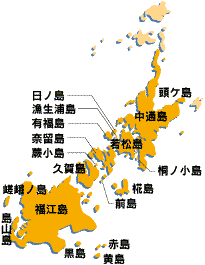
 ACCESS
ACCESS
Fukue City can be reached by passenger boat, ferry, jet-foil and airplane.
Air Nippon Direct flights to Goto Fukue Airport (FUJ) from Fukuoka and Nagasaki.
How to get to Fukue Island Schedules (in Japanese)

 JOUHOU / GENERAL INFORMATION
JOUHOU / GENERAL INFORMATION
Fukue (or "Hukue" as they romanize it) (Japanese only)
Goto No. 1 Boy's guide to Goto-retto (Japanese only) 
"Welcome to Goto,Wind is blowing to Goto, Wave is coming to Goto"
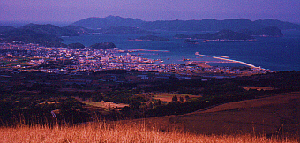
View of Fukue City from the summit of Onidake volcano

 KEMBUTSU / SIGHTSEEING
KEMBUTSU / SIGHTSEEING
JNTO Japan Travel Update: Fukue Island 
A Moon Travel Handbook account of Fukue Island's sights 
Goto-retto, Fukue-shima 
Lots of images and explanations of Fukue Island's sights (in Japanese)
Welcome to Fukue Island! Nagasaki Goto
Images of major sightseeing attractions
Goto, Fukue Photo Map 
Click on the name of a sight around Fukue Island to view photos
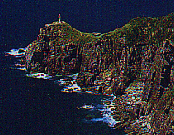
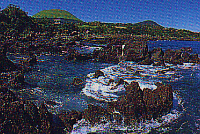

See the ocean from Fukue Island's rocky cliffs, lava flows and sandy beaches.
(images courtesy of Fukue City)

 MATSURI / FESTIVALS
MATSURI / FESTIVALS
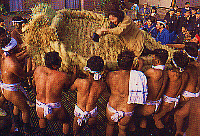
(image courtesy of Goto Archives) |
Hetomato 16 January
As part of the new year celebrations, young men carry a giant straw zori (sandal) around town and use it as a trampoline for unsuspecting spectators!
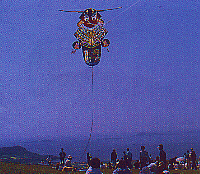
(image courtesy of Goto Archives) |
Baramon-dako 03 May
The wind atop (inactive) Onidake volcano is strong enough to fly the giant baramon-dako (baramon kite).
- Nagasaki no oto (Sounds of Nagasaki): baramon-dako Hear the sound the kite makes


(image courtesy of Goto Archives) |
Chankoko Odori Matsuri 13-15 August
Obon wouldn't be complete without the Chankoko dancers!
- Chankoko (in Japanese)

- Chankoko (in Japanese)

- Nagasaki no oto (Sounds of Nagasaki): Chankoko dance Hear the dance song

The Chankoko dance is a Buddhist dance to invoke deities during Obon, the Japanese Festival of the Dead, 13-15 August. Families who have had a death in the past year ask Chankoko dancers to perform the in their garden or by their family grave.
Young men, wearing deep blue undergarments, a hat adorned with flowers, and a straw loincloth, march through the streets beating a gong ("Chan!") and a drum ("Ko ko!") and singing, "Oh, omo, ondeoniyamiyohde" (the meaning is no longer known, but it might be a Buddhist sutra). Only men do the dance, and they practice nightly for two weeks leading up to Obon.
The origin of the Chankoko dance is probably the islands south of Japan. How this tradition was incorporated into Obon is lost in the mist of time. It has been performed for at least 800 years -- it was first mentioned in records in 1187 when the founder of the Goto Clan, Iemori Uku, entered Goto Castle.
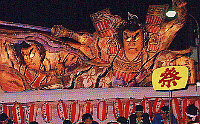
(image courtesy of City of Fukue) |
Fukue Matsuri First Weekend in November
Goto Tsubaki (Camellia) Festival Winter

 SPORTS
SPORTS
Goto Country Club Golf, anyone?
Ironman Triathlon Japan
2.4 mile swim - 112 mile bike - 26.2 mile run (Course Description)
Tokitsuumi A sumo rikishi from Fukue
Miiraku Matsuri What is a jibikiami?
Scuba diving (Under Construction)
Onsen (Hot Springs) - not a sport, but good for after sports (Under Construction)

 STORIES
STORIES
"'Field' and 'Dreams' Come Together in Fukue"
An account of an American's visit to Fukue
"New Baby, New Stress"
A brief mention of traditional Goto post-partum practices
The Longboat in Japan 
An Australian's account of a 1981 sea kayaking trip around western Japan and Goto-retto
E-mail me at thiruki@ipns.com |  |
View my guestbook | Sign my guestbook
| Discuss this topic on the Runker Room "Japan" Discussion Board |
